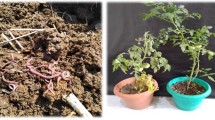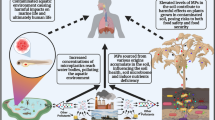Abstract
An indoor simulation experiment was conducted to explore the effects of cuticular wax content and specific leaf area (SLA) on accumulation and distribution of PAHs in different tissues of wheat leaf. Three levels (0, 1.25, 6.0 mg L−1) of mixed solution of five PAHs (Σ5PAHs) including phenanthrene (PHE), anthracene (ANT), pyrene (PYR), benz[a]anthracene (BaA), and benzo[a]pyrene (BaP) were sprayed on leaves of seven varieties of winter wheat for every other day during 20 consecutive days. Shoot and root biomass of wheat under 6.0 mg L−1 Σ5PAHs exposure were 5.87 and 0.33 g, which were significantly (p < 0.05) lower than those (7.14 and 0.65 g) without spraying Σ5PAHs solution, respectively. Elevated Σ5PAHs concentration in spraying solution significantly (p < 0.0001) decreased cuticular wax content (59.1 and 65.1 vs. 67.8 mg g−1) in leaves of wheat but exerted slight effects on SLA. Regardless of spraying Σ5PAHs or not, SLA in leaves of Jiaomai (269–276 cm2 g−1) and Zhengmai (265–285 cm2 g−1) and cuticular wax content (104–118 mg g−1) in leaves of Zhengmai were significantly higher than other varieties of wheat, respectively. Σ5PAHs concentration in cuticular waxes ranged from 24,616 to 106,353 μg kg−1, which was 2~3 orders and 1~2 orders of magnitude higher than that in mesophylls (46.0–535 μg kg−1) and leaves (785–5366 μg kg−1). There was a significant (r = 0.46, p < 0.05, n = 28) positive correlation between SLA and Σ5PAHs concentration in wheat leaves when spraying 1.25 mg L−1 of Σ5PAHs. The present study indicated that cuticular wax content was significantly (p < 0.01) positive correlated with Σ5PAHs concentration in the leaves and the translocation factor (TFw−m) of PHE, ANT, PYR, and Σ5PAHs from cuticular wax to mesophyll. Based on principal component analysis (PCA), cuticular wax content was the main limiting factor for folia uptake of PAHs in winter wheat. The present study suggested that cuticular wax could play significant roles in foliar uptake of PAHs of wheat via affecting their accumulation in cuticular wax and translocation to mesophyll.




Similar content being viewed by others

References
Chen LG, Ran Y, Xing BS, Mai BX, He JH, Wei XG, Fu JM, Sheng GY (2005) Contents and sources of polycyclic aromatic hydrocarbons and organochlorine pesticides in vegetable soils of Guangzhou, China. Chemosphere 60:879–890
Desalme D, Binet P, Chiapusio G (2013) Challenges in tracing the fate and effects of atmospheric polycyclic aromatic hydrocarbon deposition in vascular plants. Environ Sci Technol 47:3967–3981
Dias APL, Rinaldi MCS, Domingos M (2016) Foliar accumulation of polycyclic aromatic hydrocarbons in native tree species from the Atlantic Forest (SE-Brazil). Sci Total Environ 544:175–184
Dimashki M, Lim LH, Harrison RM, Harrad S (2001) Temporal trends, temperature dependence, and relative reactivity of atmospheric polycyclic aromatic hydrocarbons. Environ Sci Technol 35:2264–2267
Hoagland DR, Arnon DI (1938) The water culture method for growing plants without soil. California Agricultural Experiment Station Circular 347:1–39
Howsam M, Jones KC, Ineson P (2000) PAHs associated with the leaves of tree species. I. Concentrations and profiles. Environ Pollut 108:413–424
Howsam M, Jones KC, Ineson P (2001) PAHs associated with the leaves of three deciduous tree species II: uptake during a growing season. Chemosphere 44:155–164
Hwang HM, Wade TL, Sericano JL (2008) Aerial distribution, temperature-dependent seasonal variation, and sources of polycyclic aromatic hydrocarbons in pine needles from the Houston metropolitan area, Texas, USA. J. Environ Sci Health A Tox Hazard Subst Environ Eng 43:1243–1251
Jia HZ, Li L, Chen HX, Zhao Y, Wang CY (2015) Exchangeable cations-mediated photodegradation of polycyclic aromatic hydrocarbons (PAHs) on smectite surface under visible light. J Hazard Mater 287:16–23
Jia JP, Bi CJ, Zhang JF, Chen ZL (2019) Atmospheric deposition and vegetable uptake of polycyclic aromatic hydrocarbons (PAHs) based on experimental and computational simulations. Atmos Environ 204:135–141
Jouraeva VA, Johnsona DL, Hassett JP, Nowak DJ (2002) Differences in accumulation of PAHs and metals on the leaves of Tiliaeuchlora and Pyrus calleryana. Environ Pollut 120:331–338
Kaupp H, Blumenstock M, Mclachlan MS (2000) Retention and mobility of atmospheric particle-associated organic pollutant PCDD/Fs and PAHs in maize leaves. New Phytol 148:473–480
Kerstiens G (2006) Parameterization, comparison, and validation of models quantifying relative change of cuticular permeability with physicochemical properties of diffusants. J Exp Bot 57:2525–2533
Keyte I, Wild E, Dent J, Jones KC (2009) Investigating the foliar uptake and within-leaf migration of phenanthrene by moss (Hypnum cupressiforme) using two-photon excitation microscopy with auto fluorescence. Environ Sci Technol 43:5755–5761
Lehndorff E, Schwark L (2004) Biomonitoring of air quality in the Cologne Conurbation using pine needles as a passive sampler—part II: polycyclic aromatic hydrocarbons (PAH). Atmos Environ 38:3793–3808
Li XR (2007) Spatial distribution pattern of emission, dispersion and exposure of polycyclic aromatic hydrocarbons in Tianjin, China. Thesis of PhD, Beijing, China: Peking University, p. 152 (in Chinese)
Li YG, Chen BL, Zhu LZ (2010) Single-solute and bi-solute sorption of phenanthrene and pyrene onto pine needle cuticular fractions. Environ Pollut 158:2478–2484
Li QQ, Li YG, Zhu LZ, Xing BS, Chen BL (2017) Dependence of plant uptake and diffusion of polycyclic aromatic hydrocarbons on the leaf surface morphology and micro-structures of cuticular waxes. Sci Rep 7:46235
Liu SZ, Tao S, Liu WX, Liu YN, Dou H, Zhao JY, Wang LG, Wang JF, Tian ZF, Gao Y (2007) Atmospheric polycyclic aromatic hydrocarbons in North China: a winter-time study. Environ Sci Technol 41:8256–8261
Martí-Cid R, Llobet JM, Castell V, Domingo JL (2008) Evolution of the dietary exposure to polycyclic aromatic hydrocarbons in Catalonia, Spain. Food Chem Toxicol 46:3163–3171
Mattina MJI, Lannucciberger W, Musante C, Jason C (2003) Concurrent plant uptake of heavy metals and persistent organic pollutants from soil. Environ Pollut 124:375–378
Nizzetto L, Pastore C, Liu X, Camporini P, Stroppiana D, Herbert B, Boschetti M, Zhang G, Brivio PA, Jones KC, Di Guardo A (2008) Accumulation parameters and seasonal trend for PCBs in temperate and boreal forest plant species. Environ Sci Technol 42:5911–5916
Pan YJ (2004) Concentrations and spatial distribution of polycyclic aromatic hydrocarbons (PAHs) in a Cinnamomum camphora stand. Sci Silva Sinic 40:2–7
Schreiber L (2005) Polar paths of diffusion across plant cuticles: new evidence for an old hypothesis. Ann Bot 95:1069–1073
Shahsavari E, Adetutu EM, Taha M, Ball AS (2015) Rhizoremediation of phenanthrene and pyrene contaminated soil using wheat. J Environ Manag 155:171–176
Shen HZ, Huang Y, Wang R, Zhu D, Li W, Shen GF, Wang B, Zhang YY, Chen YC, Lu Y, Chen H, Li TC, Sun K, Li BG, Liu WX, Liu JF, Tao S (2013) Global atmospheric emissions of polycyclic aromatic hydrocarbons from 1960 to 2008 and future predictions. Environ Sci Technol 47:6415–6424
Shi TR, Tian K, Bao HY, Liu XP, Wu FY (2017) Variation in foliar uptake of polycyclic aromatic hydrocarbons in six varieties of winter wheat. Environ Sci Pollut Res 24:27215–27224
Simonich SL, Hites RA (1994) Vegetation-atmosphere partitioning of polycyclic aromatic hydrocarbons. Environ Sci Technol 28:939–943
Sun P, Blanchard P, Brice KA, Hites RA (2006) Trends in polycyclic aromatic hydrocarbon concentrations in the Great Lakes atmosphere. Environ Sci Technol 40:6221–6227
Terzaghi E, Zacchello G, Scacchi M, Raspa G, Jones KC, Cerabolini B, Guardo AD (2015) Towards more ecologically realistic scenarios of plant uptake modelling for chemicals: PAHs in a small forest. Sci Total Environ 505:329–337
Tian K, Bao HY, Zhang XC, Shi TR, Liu XP, Wu FY (2018a) Residuals, bioaccessibility and health risk assessment of PAHs in winter wheat grains from areas influenced by coal combustion in China. Sci Total Environ 618:777–784
Tian K, Bao HY, Liu XP, Wu FY (2018b) Accumulation and distribution of PAHs in winter wheat from areas influenced by coal combustion in China. Environ Sci Pollut Res 25:23780–23790
Tian L, Yin S, Ma YG, Kang HZ, Zhang XY, Tan HX, Meng HY, Liu CJ (2019) Impact factor assessment of the uptake and accumulation of polycyclic aromatic hydrocarbons by plant leaves: morphological characteristics have the greatest impact. Sci Total Environ 652:1149–1155
USEPA (1996) Method 3540C: Soxhlet extraction. US Environmental Protection Agency, Washington, DC
Wang DG, Chen JW, Xu Z, Qiao XL, Huang LP (2005) Disappearance of polycyclic aromatic hydrocarbons sorbed on surfaces of pine Pinua thunbergii needles under irradiation of sunlight: volatilization and photolysis. Atmos Environ 39:4583–4591
Wang YQ, Tao S, Jiao XC, Coveney RM, Wu SP, Xing BS (2008) Polycyclic aromatic hydrocarbons in leaf cuticles and inner tissues of six species of trees in urban Beijing. Environ Pollut 151:158–164
Wild E, Dent J, Thomas OG, Jones KC (2005) Direct observation of organic contaminant uptake, storage, and metabolism within plant roots. Environ Sci Technol 39:3695–3702
Xia ZH, Duan XL, Qiu WX, Liu D, Wang B, Tao S, Jiang QJ, Lu B, Song YX, Hu XX (2010) Health risk assessment on dietary exposure to polycyclic aromatic hydrocarbons (PAHs) in Taiyuan, China. Sci Total Environ 408:5331–5337
Yang B, Liu S, Liu Y, Li XF, Lin XB, Liu M, Liu XR (2017) PAHs uptake and translocation in Cinnamomum camphora leaves from Shanghai, China. Sci Total Environ 574:358–368
Zhang YH, Huang HJ, Xiong GN, Duan YH, Cai CY, Wang X, Li JY, Tao S, Liu WX (2020) Structural equation modeling of PAHs in surrounding environmental media and field yellow carrot in vegetable bases from Northern China: in comparison with field cabbage. Sci Total Environ 717:137261
Funding
The financial support from the National Natural Science Foundation of China (41571456), the National Key Research and Development Program of China (2016YFE0202900), and the Natural Science Foundation of Shaanxi Province of China (2019JZ-25) is gratefully acknowledged.
Author information
Authors and Affiliations
Corresponding author
Additional information
Responsible editor: Philippe Garrigues
Publisher’s note
Springer Nature remains neutral with regard to jurisdictional claims in published maps and institutional affiliations.
Electronic supplementary material
ESM 1
(DOCX 62 kb).
Rights and permissions
About this article
Cite this article
Wang, J., Bao, H., Zhang, H. et al. Effects of cuticular wax content and specific leaf area on accumulation and partition of PAHs in different tissues of wheat leaf. Environ Sci Pollut Res 27, 18793–18802 (2020). https://doi.org/10.1007/s11356-020-08409-9
Received:
Accepted:
Published:
Issue Date:
DOI: https://doi.org/10.1007/s11356-020-08409-9



